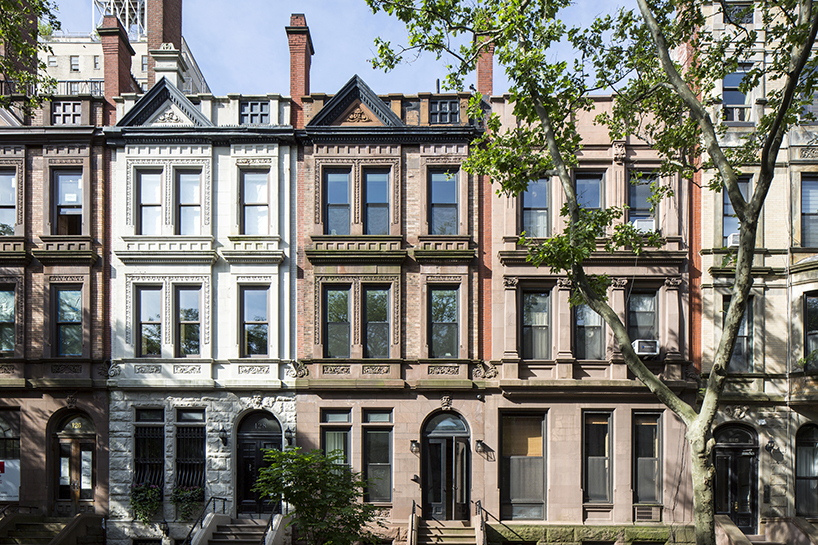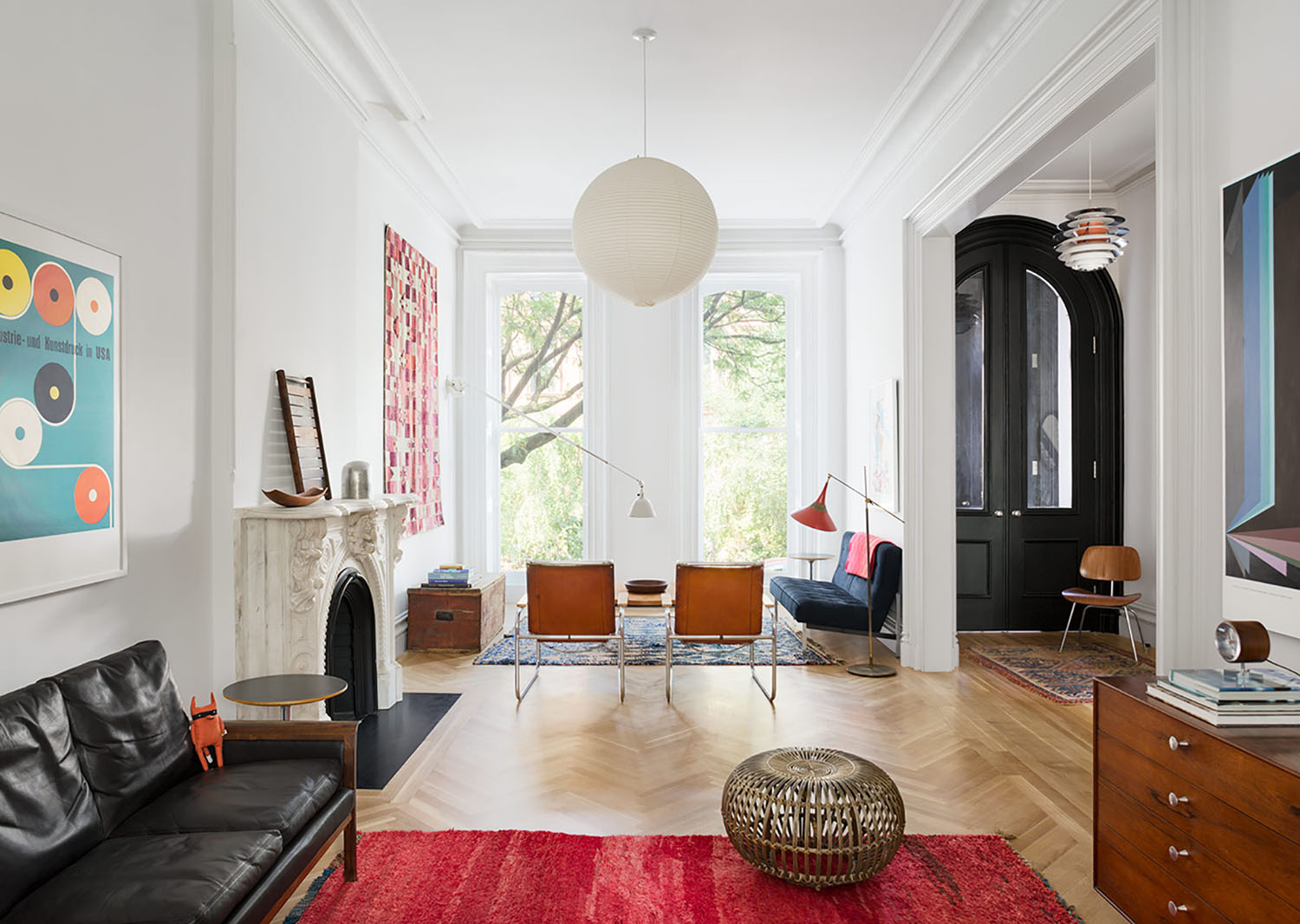Table Of Content

But given the cramped streets, true Gothic Revival style never took hold with the row houses. Instead, details were added through ironwork in fences, balconies, and stoop railings. Today, the cost of living in brownstone homes can outweigh the nostalgia of the building style. However, their charm and character still entice many homebuyers and renters. Here are a few of the pros and cons to consider when looking for a brownstone house. Due to the cost and fire resistance, brownstone became popular as a building material in New York City in the 19th century.
Development of Brownstone Architecture in NYC
It stands behind a Poul Jensen Z chair upholstered in Schumacher velvet and an Angelo Mangiarotti black marble table. On the side is a Harry Balmer patinated steel lamp atop a lacquered burl wood table by Edward Wormley. The garden-level guest room functions as a bachelor pad of sorts for close friends of the couple. Among the family heirlooms on display is an antique French barometer.
Follow Streeteasy
A brownstone is built with brown sandstone that was used to coat the front of houses built in the early 19th century (1800s). Over the years, districts such as Park Slope and Harlem have emerged as quintessential brownstone neighborhoods. They represent not just distinctive architectural features but also offer insights into evolving neighborhood identities within this pulsating city. These buildings symbolize more than architecture; they mirror the unparalleled dynamism of New York itself. While the early phases were marked by the utilitarian use of native sandstone, over time, brownstones transformed into status symbols for the wealthy, underlining shifts in societal hierarchies during diverse epochs.
Greek Revival (1830 –
The classic exterior features new, black-paned windows, adding subtle sophistication to the already elegant facade. It’s also not common to find a home with a “parlor,” a formal reception room for visitors. This parlor is updated with 21st century living in mind, featuring built-in shelving and a cozy seating area for watching TV.
The NYC walking tour of Brooklyn's most beautiful brownstones
If you can’t go up and down stairs easily, a brownstone probably isn’t for you. There are several sets of staircases throughout, and you will rarely find an elevator in a brownstone. Moving in and out, bringing up groceries, and walking upstairs can be an undertaking. Through the corridor, there is an open space people typically use as a living room. Alternatively, you could also convert this space into a guest room. While you’ll typically get some outdoor space to yourself, you’ll still share at least one wall with another home.
Private beds for rent starting at $700/month.
The bedrooms are typically on the two to three floors above the parlor. A second house in Bakersfield, which sleeps six, is currently half-full, Stallworth said. Lennox owns the Bakersfield home; Brownstone rents out the Palo Alto property, and in turn subleases it to tenants. Our shared homes are designed for you to meet new people, and live comfortably. Despite the push toward contemporary styling and Sinatra’s removal of moldings inside the home, original details like hardwood floors, stained glass doors, and fireplace mantels remain. To let in natural light, the Solomon family opened up the rear wall on the first floor, which leads to a slate- and brick-paved backyard.
The Brownstone Boys Gave New Life to This Old Building - House Beautiful
The Brownstone Boys Gave New Life to This Old Building.
Posted: Tue, 21 Nov 2023 08:00:00 GMT [source]
Stallworth and cofounder Christina Lennox live in the Palo Alto pod house along with their tenants. Just one pod is currently vacant, which Stallworth said he is working to fill. With Brownstone, Stallworth said he aims to "preserve humanity and comfort and privacy" for its occupants. "It's not even a shared house, just stacked on top of each other like filing cabinets. The world is messed up. It shouldn't be this expensive to just exist," one user said, according to Newsweek.
You can see the iconic brownstone house structure in Sex and the City episodes, countless movies, and even on Sesame Street. They are clad with a reddish-brown sandstone which was quarried in Connecticut, New Jersey, and Pennsylvania during the 19th century. This "brown stone" is triassic-jurassic sedimentary rock infused with red iron compounds, hence its distinctive color. Originally the material was used for entire structures but later it became more popular to apply it as a decorative face on brick-built row houses. With the permanent closure of the Portland Brownstone Quarry in 2012, the building material has become scarce, driving up the cost and value of brownstone houses. As a result, brownstones have become a symbol of wealth as many of the remaining homes are over 100 years old.
How Brownstones Came to Symbolize Wealth in NYC
Brownstones usually feature two windows facing the street, two to three rooms, a kitchen, bathroom, and living space. Most brownstone owners have access to a small, exterior courtyard in the back of the building. Another reason why brownstones have stood the test of time is because they were built by experienced craftsmen using brick and stone.
There was nothing the average New York City resident wanted more than to get above street level, and a stoop on a brownstone house provided that opportunity. A full exploration into Brooklyn Brownstones or any other Brownstone structures across New York City could be an endless adventure. While familiarizing oneself with landmark buildings offers a tangible experience, museums and exhibits provide deeper insights into their history. But one fact remains unchanging; every brownstone stands as a testament to NYC's architectural past and its enduring appeal to residents and visitors alike.

It was only a matter of time before St. Francis sold its old digs. They’re also popular in Brooklyn neighborhoods, Brooklyn Heights, Fort Greene, and Carroll Gardens. This makes it easy to incorporate outdoor space into the living area. The homeowner may need to add a stair and landing to get from the garden to the parlor level. Often, people repurpose the lower level into primary living space. The Upper West Side, Brooklyn Heights, and Park Slope are home to some of the largest concentrations of brownstones.
Just as Kleenex and Jacuzzi are commonly used to describe any tissue or hot tub, brownstone is a specific term that’s been stretched far beyond its narrow meaning. Today, brownstone is a word often used interchangeably with townhouse and row house. Brownstone was prized by tombstone carvers in southern New England, and Mid Atlantic region during the Colonial era.
Their wealth has changed the face of the neighborhoods they move to as they price out former residents. While there are still many brownstone houses, some developers have gutted the buildings and turned them into apartments. This allows multiple families to live in a brownstone house at once, enjoying modern amenities while still keeping the historic facade. The classic brownstone is synonymous with a certain type of New York lifestyle.
Between 1830 and 1850, Greek Revival architecture overtook the Federal style, not just in New York, but across the United States. For row houses specifically, the movement was quite subtle—façades were still made of red brick, but Ionic and Doric columns adorned doorways, while ornamental work featured Greek motifs like the acanthus leaf. For middle-class townhouse and rowhouse owners who wanted a taste of luxury, a brownstone was the way to go. Brownstone is a type of sandstone, specifically one that dates back to the Triassic-Jurassic period. When first cut, the stone is actually pink, but deepens into its classic brown hue once it’s been exposed to the elements.

No comments:
Post a Comment